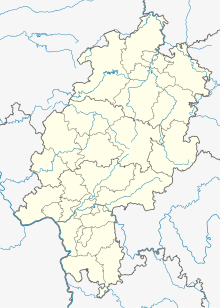Wedge Mill (Zwesten)
Coordinates: 51 ° 2 ′ 54 ″ N , 9 ° 11 ′ 12 ″ E
The wedge mill , also known as the Bruchmühle , is a watermill on the Schwalm near Bad Zwesten in the Schwalm-Eder district in northern Hesse, which was operated from the 14th century until it was closed in 1960 . Today it is used to generate electricity by means of a turbine , while the buildings and agricultural areas have been used as riding stables since around 2010 and contain several holiday apartments.
Geographical location
The property is located 193 m above sea level on the western orographic left bank of the Schwalm, where it flows around the Altenburg (432.7 m) in the Löwensteiner Grund to the west, between the Wälzebach in the north , which flows into the Schwalm, and that through a weir The operating ditch branched off about 350 m further south from the Schwalm , which flows back into the Schwalm immediately below the mill. The old village center of Bad Zwesten is about 1 km to the north-west, and the federal road 3 from Marburg to Kassel runs about 550 m to the west between the village and the mill from south to north. On the opposite, eastern bank of the Schwalm there is a large campsite at the foot of the Altenburg. About 400 m to the south-west is the so-called "Löwensprudelpark", the small spa park with the seven Zwestener springs , to which the place owes the title "Bad" .
Viewed in the direction of the river, the wedge mill is the first of three Zwesten mills in this section of the Schwalm; the Leomühle and the Otto mill are approx. 450 m and 1000 m further downstream.
history
The first mill at this point was probably built by the Lords of Löwenstein in the 14th century. It remained in their possession until 1566, when Otto von Löwenstein sold it. In 1602, a Henry Boch is as Beständer handed (tenant) of the "bruchmule"; this name can be found with modifications until 1670: "Bruchmölle" (1661, 1670) and "Bruchmühle" (1670). Thereafter it is mostly referred to as the “Wedge Mill” (1835 and 1872), but from 1888, when it came into the possession of the Damm family, it was also referred to as the “Dammühle” or “Damm-Mühle”.
It is said to have received the name "wedge mill" due to its location on a wedge-shaped piece of land between the two watercourses of the Wälzebach and the Schwalm or the mill ditch. The name "Bruchmühle" probably comes from the fact that the mill was on the edge of the "Bruchwiesen", the swampy terrain southeast of the village between the Schwalm and the road to Niederurff , where the Zwesten springs are now to be found.
Johann Dippel in 1661 and Johann Milzer, who ran the mill from Hermann Dippel the Elder in 1669, have been handed down as Bruchmüller. J. took over. In 1888 the mill came to the Damm family, who operated it until 1960 and owned it until 2010. It is not yet known who was Bruchmüller in the two centuries in between.
Mill
After the construction of a weir in the Schwalm and the mill ditch running on its own property in the years 1825–1826, the mill had a secure water supply all year round. The farm buildings with barn and stable belonging to the property today were dismantled in Niederurff in 1836 and then rebuilt here.
The mill was originally driven by three undershot water wheels , one each for the grinding , the beating and the sawmill . With the removal of the beating passage, the corresponding mill wheel was also removed. The larger one with a diameter of approx. 6.5 m remained for the grinding and crushing pass and a second, approx. 4.5 m in diameter for the sawmill.
In 1960 the last, the large mill wheel, was dismantled. A water turbine was installed, and since then the former mill has been generating electricity that is fed into the Energie Waldeck-Frankenberg GmbH (EWF) network.
Todays use
In 2010, the last heiress of the Müller dynasty Damm sold the approximately 50 hectare agricultural property with all buildings and facilities. Since then, in coordination with the State Office for the Preservation of Monuments in Hesse , the buildings have been renovated, the turbine system has been modernized and the barn and stable have been used for hobby breeding for American Quarter Horses . Riding lessons and guided rides are offered.
Footnotes
- ↑ Initially in the network of Stadtwerke Korbach GmbH, which merged in 2003 with the Verbandselizitätswerk Waldeck-Frankenberg GmbH to form EWF.
literature
- Werner Ide: From Adorf to Zwesten: Local history paperback for the Fritzlar-Homberg district. Bernecker, Melsungen, 1972, p. 432.
- Waldemar Küther (edit.): Historical local dictionary Fritzlar-Homberg . Elwert, Marburg, 1980, ISBN 3-7708-0679-4 , p. 38.
Web links
- Wedge mill (Bruchmühle), Schwalm-Eder district. Historical local lexicon for Hesse (as of February 17, 2014). In: Landesgeschichtliches Informationssystem Hessen (LAGIS). Hessian State Office for Historical Cultural Studies (HLGL), accessed on May 28, 2019 .
- The wedge or curd mill
